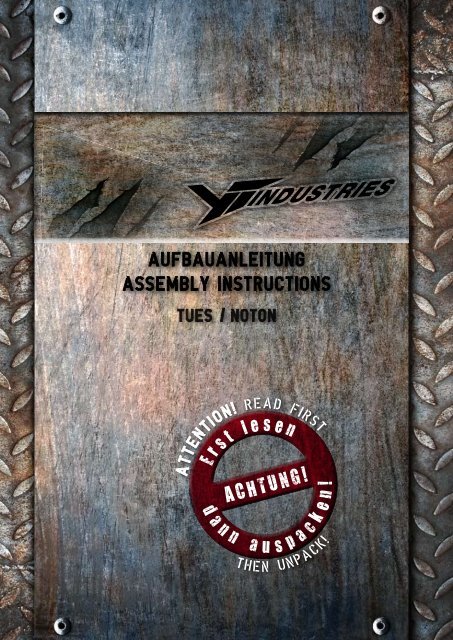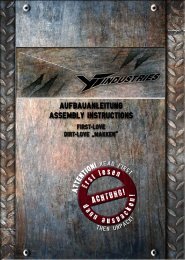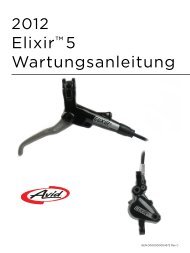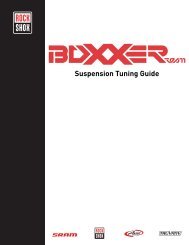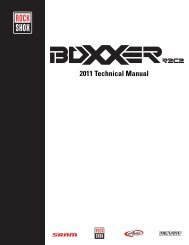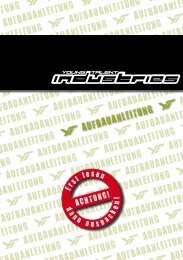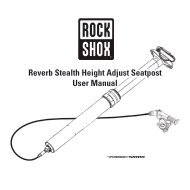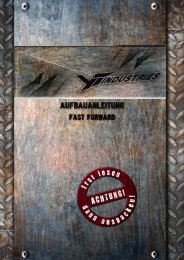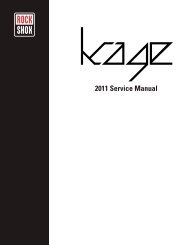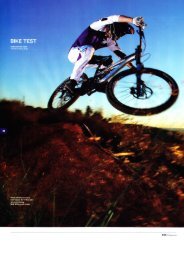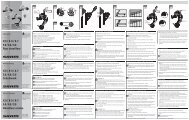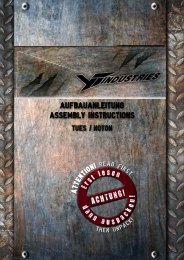Assembly Instructions - YT Industries
Assembly Instructions - YT Industries
Assembly Instructions - YT Industries
- No tags were found...
You also want an ePaper? Increase the reach of your titles
YUMPU automatically turns print PDFs into web optimized ePapers that Google loves.
<strong>Assembly</strong> instructions for <strong>YT</strong> <strong>Industries</strong> “TUES”and “NOTON” mountain bikeCongratulations to your new bike and thanks forpurchasing a <strong>YT</strong> <strong>Industries</strong> mountain bike.Please note: a mountain bike is a piece oftechnical sports equipment that in orderto function and sustainably please the userdemands some technical know-how and manualskill for assembly and maintenance.Furthermore we assume, that the users ofour bikes possess suitable tools in order toexecute the necessary assembly steps withoutdamaging the parts. These assembly instructionscannot replace a professional training as bikemechanic. This manual is not meant as basis forprofessionally assembling a piece of high techsports equipment, like a mountain bike, fromsingle parts or repairing such.Please understand that in case of self-executedrepairs or non-professional maintenancewarranty for parts shall be void and we shall notaccept liability for consequential accidents ordamages.We enjoin you: if you don’t feel confident toperform the necessary maintenance and repairsappropriately, assign a bike shop! Of course, youcan always contact us if you have any queries.But our exclusion of warranty and liability appliesin this case, too. When dealing with inquires byphone or mail, we cannot ensure that the extentand manner of the incidental workings have beendescribed correctly and completely and thereforewe cannot control if our work instructions havebeen implemented correctly and to the fullextent.You may reach us by email at: info@yt-industries.comTools needed for the following assembly steps:Torque wrench with Allen keyadapter size 5 and 6Allen key size 5 and 6Torque wrench with socketkey 17 mmSide cutterAir pumpInflator<strong>Assembly</strong> grease13
UnpackingRemove the brass-coloured metal clips with aside cutter in order to avoid injuries or scratcheson the bike when unpacking. Gently removethe wheel from the box. Remove the frame andcautiously put it down on the rear wheel and thefork dropouts. Check all parts for damage andcompleteness. The shipment includes:•Wheels, pedals•Mounted frame•Saddle with seat post•Stem cover with 4 screws•20mm Thru axle•12 thru axle and screw nutPlease keep the packagingmaterial and out packagefor potential services.Remove the packaging and padding from theframe. Slit the cable ties at the handlebar. Holdthe handlebar to prevent the handlebar fromfalling down and being damaged.Saddle and handlebarassemblyOur frames are prepared to install the seat postwithout problems.Despite best care and attention from our side:Please double check!Lubricate the seat tube.Now insert the seat post up to the half and fix itwith the quick release.Modell_TUESBolt down the stem on the upper fork crown withthe required torque (8,5 Nm).14
Now mount the handlebar. (Allen key size 5)1 342Torque the screws step by step with just oneturn to cross. This is the only way to clamp thehandlebar evenly in the stem. The torque of 9,5Nm must be accurately maintained. Pay attentionto an even clamp gap and the exact centeredfitting of the handlebar. The setting lines will helpyou with that.Turn your bike and cautiously put it down onsaddle and handlebar. Use a soft underlayer toavoid scratching.BrakeRemove the transport lock from the brake caliper.(Please keep the transport lock safe)Do not activate the brake leverwithout the transport lock!15
Front Wheel TUESGuide the brake disk carefully inside the brakecaliper.Slide the axle through the dropouts of the fork.Slide the axle (maxle DH) through the dropoutsof the fork. Then bolt down the thru axle from thedrive side into the dropout.Apply grease to the screw thread.Tighten the screws until you have reached therequired torque (5.7 Nm).Please also attend to the attached 2010 OwnersManual of RockShox or check the manual onlineat www.sram.com.Afterwards secure the maxle DH.Turn the non-drive side bolt clockwise untilyou hear 8 cliks or you reach a torque valueof 3.4 Nm.Please also attend to the attached 2010 OwnersManual of RockShox or check the manual onlineat www.sram.com16
Front Wheel NOTONGuide the brake disk carefully inside the brakecaliper.Slide the axle through the dropouts of the fork.Slide the axle (maxle360) through the dropoutsof the forkApply grease to the screw thread.To tighten the axle into the dropout, turn the axlelever clockwise until hand tight.Please also attend to the attached 2010 OwnersManual of RockShox or check the manual onlineat www.sram.comAfterwards secure the maxle360.Lift the lever out of the corresponding slot in theaxle and rotate to a point 180 degrees whereyou want the lever to be located in the closedposition.Then close the Maxle quick release lever.Please also attend to the attached 2010 OwnersManual of RockShox or check the manual onlineat www.sram.com17
Mounting of the rearwheelPull the rear derailleur backwards for thefollowing assembly steps.The rear derailleur should stay at the lowestshifting position.Put the chain over the smallest sprocket andguide the brake disk carefully inside the brakecaliper. Arrange the hub between the rear enddropouts.Now insert the the thrue axle from the nonedrive side.Please apply grease to the screw thread.Then bolt down the 12 mm thrue axle by usingthe torque wrench with socket key 17 mm.Tighten the thru axel until you have reached therequired torque (12 ± 1 Nm).18
Bolt down the screw nut on the opposite side.Finally tighten the screw nut until you also reachthe required torque (12 ± 1 Nm).Mounting pedalThoroughly grease the pedal thread prior toassembly. By doing so you facilitate futureexchange. Set the paddle straight in a right angle,in order to avoid damaging the crank arm thread.Attend to the “left thread” in the left pedal. Theright pedal is located on the side of the chainringand has a right thread. For both pedals thetightening torque is 38 Nm.The left pedal is marked with a circumferentialslot arround the axle.right pedal (drive side) ➡ right-hand threadleft pedal (non drive side) ➡ left-hand threadTorque 38 Nm (+2 Nm)19
Now rotate the crank into driving direction toensure the right positon of the chain on the rearsprocket.Pay attention to the brake tube and shifting cabel– both must not be in contact with the tire.Montage HinterradTUESCheck the tight fit ofthe pedals once againafter 50 km of riding.Pump up the shock (Noton) with an appropriateair pump according to your weight. Also attendto the “Adjustment of Suspension Elements”.Inflate your wheels to at least 1.8 bar and testtheir unobstructed movement. Particularly payattention that the brake tube is not rubbing orgets caught. Use the brake lever and check thepressure point. In order to change the pressurepoint, please refer to the attached manual of themanufacturer.A test ride on easy terrain will give you certaintyto have mounted everything correctly. In thiscontext we also point to the paragraph “Get toknow your bike”.20
Adjusting the fork and shockThe suspension elements we use allow for manyadjustments. Please refer to the attached detailedinstructions (Owners Manual) of the suspensionmanufacturer „MARZOCCHI“ & “Rockshox” or go towww.marzocchi.com or www.sram.comIt’s imperative that you adhere to the air pressureguidelines of the manufacturer!Basic adjustmentThe main criteria for the set up of the rear shock and forkare: - the weight of the rider„sag“- and his position on the bikeSag refers to how much a suspension moves under just thestatic load of the rider. Sag is the first parameter for adjustingthe suspention. At our bikes the sag should be between25 % and 40 % of the total travel.You will find the suitable set up for your style by testingdifferent settings.Chose a easy, well-known terrain for your first test rides.Don’t forget: only practice makes perfect.Before using your bike each timeMountain bikes are naturally maxed out. Bike parts reactquite differently under load, ranging from wear and tearto material fatigue. A sudden collapse of single partsmay occur. Regularly check your bike for damage andperiodically take it in for service.Prior to each ride you should check:The tight fit of wheels in frame and fork and the tight fitof your seat postThe functioning of your wheels (free movement)The air pressure in your tires, the tension of the spokesand the slackness of the hub bearingsThe functioning of the brakesSigns of material fatigue (deformation, fractions, cracks,damage spots…)All other components regarding stability and reliability.Don’t ride if one of these deficiencies occurs.Please consider: each adjustment has an influence on thebehavior of the bike – take care of yourself at the first testrides.Danger of crashing!Avoid all settings of suspension elements that will result infrequent snap-through. The parts will reward that with along lifespan.In case of uncertainty we enjoin you to call upon theservices of <strong>YT</strong> <strong>Industries</strong> or the MARZOCCHI/RockShoxrepresentativeinfo@yt-industries.comYou had a crashCrashes are a strain on your bike and its parts. Before youcarry on after a crash, always check your bike for damageand impaired functioning (also refer to “Before using yourbike each time”).Don’t carry on riding if one of these deficiencies occurs.In case of uncertainty we enjoin you to call upon theservices of <strong>YT</strong> <strong>Industries</strong> or a professional bike shop:info@yt-industries.com.Get to know your bikeFamiliarize yourself with your new bike! Make sure that allscrews have been tightened with the correct torque, referto the attached table.Our bikes come equipped with modern disc brakes withextraordinary braking power. The braking power increasesafter a short running-in period. Get used to the brakeperformance, testing it on different terrain. Position thebrake lever and shifting lever “grip-compatible”, so that itcan be pulled without cramping.Riding on public roads in GermanyThe German traffic regulations (StVZO) stipulate the useof bicycles on public roads and paths with the followingsafety precautions: a brake and lighting system as well asa bike bell. Furthermore each cyclist is bound to maintainhis/her vehicle in a roadworthy condition. We explicitlystate that our bikes are not road-going (street legal)according to the German StVZO.21
Riding outside GermanyFor clients who purchase or use their <strong>YT</strong> <strong>Industries</strong>mountain bike outside Germany: please enquire yourselfabout the traffic regulations that apply in your country.Designated UseIn addition to our assembly instructions you find the usermanuals of the component manufacturers enclosed to yourbike. They contain information about use, maintenance andcare of the respective product. Follow the directions andkeep the manuals safe.Damages that result from improper and inappropriate use,are not included in our warranty.This includes:Improper or poor maintenance and careDamages caused by crashes or overload/ overstressingChanging of the frame or forkChanging of componentsJumps or other strains that result in overstraining thebikeOperating the bike with a total weight exceeding 120 kgPlease also refer to our General Terms and Conditions atwww.yt-industries.comImportantWe shall not be liable for physical damage or personalinjury that result from using the mountain bike. From anoutside perspective, skills of professional mountain bikeriders often seem easy to copy. In reality these skills are theresult of many years of training and constant practice.For your own safety, always wear appropriate protectiongear. We furthermore recommend wearing a helmetwhenever using your bike.Things always seem to happen when you least expectthem.Maintenance and Service IntervalsOnly regular service inspections, maintenance and careas well as immediate professional repairs or exchangeof damaged parts guarantees a long-lasting and safefunctioning of the bike.If you don’t have the required skills and tools to do theincidental work yourself, you need to consult a bike shop.In the following we have prepared some maintenanceadvice for you:First inspection after 5 to 15 hours of operation shouldinclude the following:Check the tightening torque of all crews and nuts, ifnecessary tighten screws and nutsCheck concentricity and spoke tension of wheels, tightenspokes if necessaryMonthly inspections:Check profile and sides of tires, replace worn-out tiresMeasure thickness of brakewwws, replace pads anddisc if necessary (adhere to the specifications of themanufacturer)Check your brake system for leak tightness; consult abike shop in case of leakageCheck slackness of bearings at bottom bracket, headsetbearing hub and pedals, tighten if necessaryCheck concentricity and spoke tension of wheels, tightenspokes if necessaryCheck the tightening torque of all crews and nuts, ifnecessary tighten screws and nutsClean and lubricate drivetrainAnnual Inspections:Fork service: adhere to the specifications of themanufacturerDemount and clean bottom bracket, lubricate assemblythreadDemount and check headset bearing apply grease tobearing carrierDemount stem and seatpost, check for cracks anddamages, replace if necessaryCheck wear and tear of sprocket and chain, replace ifnecessaryCheck the shifting cables for cracks and damages,replace if necessaryRIDE ON!Your Young Talent <strong>Industries</strong> TEAM!22
Torque Tightening ValuesScrew connections are subject to settling properties, which inevitably results in decrease of clamping force. Therefore aregular check of all screw connections is essential!In addition to this table, please adhere to the user manuals of the respective component manufacturer! (www.sram.com,www.marzocchi.com)Bottom braketBrake caliper screw to frame and forkShifting lever33 - 41 Nm9 Nm (BW)9 Nm (FW)2,5 - 4 NmDisc brake screws to hubRear derailleur (fastening bolt)Chain tensioner (fastening bolt)Rear derailleur (cable fixing)6 Nm8 - 10 Nm4 - 5 NmBrake lever2,8 - 3,4 NmFree wheel counter nutStem (head tub clamping)Stem (fork crown clamping)Crank boltsChain ring screws40 Nm9,5 Nm8,5 Nm31 - 48 Nm12 - 14 Nm (steel)8 - 9 Nm (alu)23Englisch 01/2010 © youngtalentindustries sponsoree.com


